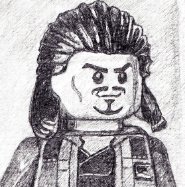Essays, Not Rants! 070: Dialogue in Fight Choreography
Did you see Man of Tai Chi? Don’t bother; the acting’s questionable, plot is tenuous at best, and the dialogue is stilted. And that’s just the surface. The one thing that makes the movie remotely remarkable is its choreography: more so than in many other movies, the fight scenes seem to convey not only the growth of the protagonist but a sort of dialogue between the characters as well.
Let me explain (and I will spoil everything because there’s no need to see the movie besides this). Tiger (yes, that is the main character’s name) is a naive practitioner of Tai Chi. His first fight or two are in tournaments where he’s primarily defensive and uses his opponents’ strength against themselves. After he’s recruited as a prizefighter by Donaka and becomes more accustomed to it, his fighting style shifts to a more aggressive form. So great. There’s character development. Big deal.
Where Man of Tai Chi gets really interesting is during the more important fights, that is Tiger versus his mentor and Tiger versus Donaka. The way each combatant fights speaks in lieu of meaningful conversation or much in the way of substance. In the former fight we see just how far Tiger has fallen: he’s gone over to the kung fu dark side and he attacks his mentor who deflects every blow as Tiger grows more and more frustrated. It’s this fight (especially in comparison to an earlier training scene) that informs us of their shifting relationship. Where before Tiger was content to be bested, now he vainly tries to overpower his master. When Tiger mirrors his master’s stance in the final showdown against Donaka, we see that he’s come back to the light side. That and the fact that he’s fighting the villain/his prior employer, obviously.
This isn’t anything new. The exponentially better film The Princess Bride has the famous duel between Inigo Montoya and The Man In Black. Yes, they talk throughout the fight, but there’s no dissonance between their swordplay and intentions. Each has garnered a measure of respect from the other and, if anything, the fight seems friendly. Neither are employing dirty tricks to gain the upper hand (thereby showing that killing the other is his priority) nor is one taunting or baiting the other. In light of the duel is it any wonder we readily accept both of these seemingly villainous characters as heroes by the end?
It’s this sort of communicative swordplay that made the duels in the original Star Wars films so captivating. Where the prequels had a lot of flash and epic scores, the classics had character. Look at the duel between Luke and Vader in The Empire Strikes Back. Vader lets Luke take the offensive for much of it. Why? Because Vader’s plan rests on him imprisoning Luke rather than killing him. Like The Princess Bride, we’re told this beforehand but it’s reflected even stronger in the choreography. In The Phantom Menace, why do Qui-Gon, Obi-Wan, and Darth Maul end up in the exhaust shaft? Is Maul leading them there or is he being pushed back? Where’s the dialogue?
Now, Neo fighting a seemingly endless number of Agent Smiths or Gipsy Danger brawling a Kaiju aren’t duels in the same way as the other examples. Sure, there’s an understood dialogue to those fights, but it tends to be limited to deciding who’s better. Duels like in The Empire Strikes Back or The Princess Bride have a conversation to them. In the case of Man of Tai Chi the fight choreography carries more than anything said verbally. Still doesn’t redeem that movie, though.



3 Comments
Recommended Comments